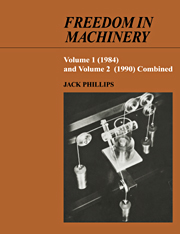Book contents
- Frontmatter
- Dedication
- Contents
- Preface
- General introduction
- 1 Mechanism and the mobility of mechanism
- 2 Overconstraint and the nature of mechanical motion
- 3 Some of the various lines in a moving body
- 4 Enumerative geometry and the powers of infinity
- 5 Rigidity and the instantaneous screw axis
- 6 Irregularity and the freedoms within a joint
- 7 The possibilities in reality for practical joints
- 8 Some elementary aspects of two degrees of freedom
- 9 The linear complex of right lines in a moving body
- 10 Line systems and the dual vectors in mechanics
- 11 Geometrical properties of the linear line systems
- 12 The vector polygons for spatial mechanism
- 13 On the two theorems of three axes
- 14 Some reciprocities across the middle number three
- 15 The generality and the geometry of the cylindroid
- 16 The discovery in a mechanism of a cylindroid
- 17 Action, notion, clearances and backlash
- 18 Singular events in the cycles of motion
- 19 Fundamental relations and some algebraic methods
- 20 The special geometry of some overconstrained loops
- 21 The helitangent lines in a moving body
- 22 The cylindroid in gear technology
- 23 The general and the special screw systems
- Bibliography
- Index of proper names
- Subject Index
7 - The possibilities in reality for practical joints
Published online by Cambridge University Press: 07 September 2010
- Frontmatter
- Dedication
- Contents
- Preface
- General introduction
- 1 Mechanism and the mobility of mechanism
- 2 Overconstraint and the nature of mechanical motion
- 3 Some of the various lines in a moving body
- 4 Enumerative geometry and the powers of infinity
- 5 Rigidity and the instantaneous screw axis
- 6 Irregularity and the freedoms within a joint
- 7 The possibilities in reality for practical joints
- 8 Some elementary aspects of two degrees of freedom
- 9 The linear complex of right lines in a moving body
- 10 Line systems and the dual vectors in mechanics
- 11 Geometrical properties of the linear line systems
- 12 The vector polygons for spatial mechanism
- 13 On the two theorems of three axes
- 14 Some reciprocities across the middle number three
- 15 The generality and the geometry of the cylindroid
- 16 The discovery in a mechanism of a cylindroid
- 17 Action, notion, clearances and backlash
- 18 Singular events in the cycles of motion
- 19 Fundamental relations and some algebraic methods
- 20 The special geometry of some overconstrained loops
- 21 The helitangent lines in a moving body
- 22 The cylindroid in gear technology
- 23 The general and the special screw systems
- Bibliography
- Index of proper names
- Subject Index
Summary
Some remarks connecting with chapter 6
01. Associated with each set of points of contact and its associated tangent planes and contact normals at a simple joint in mechanism, is a system of motion screws; this is explained in chapter 6. The so-called system of screws or the screw system is simply the set of all of the IS As which are available for relative motion at the joint. It is taken for granted in chapter 6 that the simple joint is considered alone (§ 1.28), and that contact is not being lost at any of the points of contact at the joint (§ 6.15, § 8.12).
02. Provided each one of the contact normals at a joint is projectively independent of the other contact normals at the joint (§ 3.32), the system of motion screws at the joint takes for its numerical name the number six minus the number of points of contact. This matter is thoroughly canvassed in chapter 6; with two points of contact there is discovered and explored the quasigeneral 4-system for example, with three, the quasigeneral 3-system, and so on.
03. It is important to see that in general the systems of screws of which I speak in chapter 6 – they are the systems of motion screws – contain no screws which lie along the contact normals at the points of contact at the joints. The contact normals at any one joint belong as screws of zero pitch to other systems of screws, which are, as we shall see, reciprocal to the mentioned systems.
- Type
- Chapter
- Information
- Freedom in Machinery , pp. 104 - 129Publisher: Cambridge University PressPrint publication year: 2007



